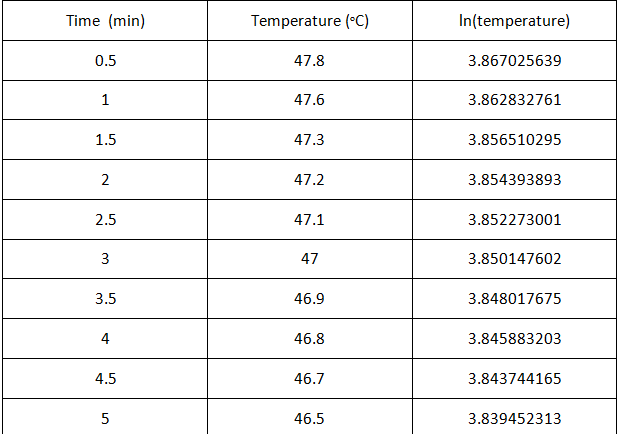The specific heat capacity is an intrinsic property of an object, and depends on the material that the object is made of. For water, the specific heat capacity is 4.184 J/(g C°).
To measure the specific heat of an object, we can first heat
it to some known temperature, say the boiling point of water. Then, we transfer
the object to a water bath of known mass and initial temperature. Finally, we
measure the final equilibrium temperature of the system (the object, the water
in the bath, and the water-bath container). If the system is thermally isolated
from its surroundings (by insulating the container, for example), then the heat
released by the object will equal the heat absorbed by the water and the
container. This process is called calorimetry, and the insulated water container is called calorimeter.
A calorimeter is composed of an insulated vessel, which prevents heat released by a thermal interaction inside the vessel to escape into the surroundings. In this activity, the calorimeter consists of stacked coffee cups. The calorimeter is partially filled with tap water. The sample is then mixed into the tap water and the ΔT of the tap water is measured. If the calorimeter initially has the same temperature as the tap water, the amount of heat lost by the hot water is equal to heat absorbed by the tap water and the calorimeter:
The experiment is split into two parts. In the first part, the heat capacity of the calorimeter will be determined.
This information will then be used in the second part, the determination of the specific heat capacity of metal samples.
HOT: 82 oC – 83g
TAP: 29.1 oC – 68g
Plugging in the values,
Trial 1, Tf = 56.09 => qgained-calorimeter 1318.84 J => Ccal = 48.86 J/ oC
HOT: 81 oC – 54g
TAP: 29.1 oC – 84.7g
Trial 2, Tf = 47.8, q = 874.07 => Ccal = 46.74 J/ oC
HOT: 71.2 oC – 70.9g
TAP: 29.4 oC – 75.4g
Trial 3, Tf = 48.96 q = 426.73 C = 21.82 J/ oC (dont know bakit siya lumayo maybe last trial, and naalala ko minadali na namin to kasi kukunin na yung hotplate :( )
So we get 48.86 J/ oC, 46.74 J/ oC, and 21.89 J/ oC values for Ccal. So the Ccal average is 39.14 J/ oC. Since the theoretical value is not given we don't know if our data is accurate (malamang malayo kasi di precise e).
Next part of the experiment is the calculation of the specific heat of two given metal, aluminum and copper using the computed Ccal. Unfortunately our data here are nowhere to be found (seryoso po mam) huhuhu. (may mga bagay talagang hindi nagpapaalam na mawawala kusa na lang itong maglalaho huhuhu ). The calculation for the specific heat of aluminum and copper are the same as with Ccal. Plug and play lang, given ka na ng lahat specific heat of aluminum at copper na lang yung unknown. From the experiment you can get the Final temperature and initial temperature reading and the masses. Tapos ayon plug and play na lang.
TAP: 29.4 oC – 75.4g
Trial 3, Tf = 48.96 q = 426.73 C = 21.82 J/ oC (dont know bakit siya lumayo maybe last trial, and naalala ko minadali na namin to kasi kukunin na yung hotplate :( )
So we get 48.86 J/ oC, 46.74 J/ oC, and 21.89 J/ oC values for Ccal. So the Ccal average is 39.14 J/ oC. Since the theoretical value is not given we don't know if our data is accurate (malamang malayo kasi di precise e).
Next part of the experiment is the calculation of the specific heat of two given metal, aluminum and copper using the computed Ccal. Unfortunately our data here are nowhere to be found (seryoso po mam) huhuhu. (may mga bagay talagang hindi nagpapaalam na mawawala kusa na lang itong maglalaho huhuhu ). The calculation for the specific heat of aluminum and copper are the same as with Ccal. Plug and play lang, given ka na ng lahat specific heat of aluminum at copper na lang yung unknown. From the experiment you can get the Final temperature and initial temperature reading and the masses. Tapos ayon plug and play na lang.
Reference
1. “Experiment 7 Temperature Measurement,” Laboratory Manual for Physics (Physics 73.1), (2013).
2. Tipler, P., Mosca, G. Physics for Scientists and Engineers. Chapter 25. W. H. Freeman and Company, New York, 2008.
1. “Experiment 7 Temperature Measurement,” Laboratory Manual for Physics (Physics 73.1), (2013).
2. Tipler, P., Mosca, G. Physics for Scientists and Engineers. Chapter 25. W. H. Freeman and Company, New York, 2008.







Walang komento:
Mag-post ng isang Komento